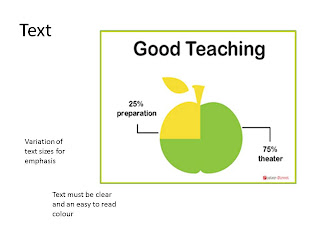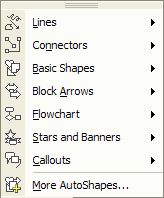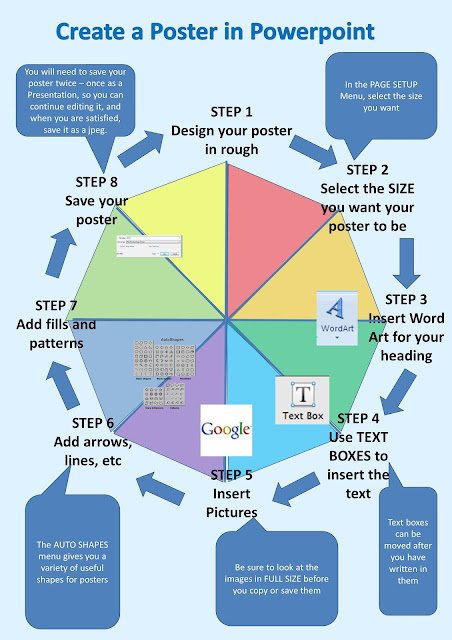PRESENTATION
A Powerpoint should be clear and easy to read. Distracting fonts and backgrounds are annoying and stop the learner from concentrating on the content, which is what it is all about.
You should never READ from a Powerpoint – you should SPEAK about the points on the slides.
Making the points on the slide appear one at a time (animation) is an effective way to keep learners engaged
Transitions and animations can add interest, but if they are too wild or wacky, learners spend most of their time thinking about what is coming next, and not listening to the important information you are giving them.
MAKING A POWERPOINT PRESENTATION
1. PLAN what you want to say
Make a Storyboard that will enable you to plan carefully
2. OPEN the Powerpoint programme – it is part of the MS Office suite
3. LAYOUT
When you open a NEW slideshow:
- The Opening slide will always be a TITLE slide
- Subsequent slides are always TITLE and CONTENT slides
- You can change the LAYOUT of the slide by clicking on the LAYOUT button
4. NEW SLIDES
You insert a new slide from the HOME menu in Office 2010 and 2013, or
from the INSERT menu in older versions.
You can create your new slide from scratch, but you might like to add a slide you have already saved somewhere else – part of another lesson, for example. Or you may wish to duplicate a slide you have already put in – especially useful in Foundation Phase for repetition.
On the NEW SLIDE menu, look for USE SLIDE FROM OUTLINE and DUPLICATE SLIDE
5. DESIGN
This tab allows you to change the theme and background of your slide. If you wish to use your own background on all the slides, select a background or even a picture.
In the VIEW menu, you can use SLIDE MASTER view to add the picture to all the slides.
I would suggest that you lighten the picture so that it doesn’t overpower the text.
6. INSERT
This tab has all the same options as the other OFFICE applications.
In Powerpoint you do not need to go to the Menu - you can insert different objects from within the slide
CALL OUTS are really useful. If you don’t like the colour that the programme gives you, right click and FORMAT the shape – this allows you to change the fill and the line colour
Another useful tool is ARROWS – again, right click and FORMAT SHAPE to make them thicker and change the colour. You can also ROTATE them so you can use them to point to your headings or diagrams
See the Blog Post on POSTERS about INSERTING PICTURES from the INTERNET
SMART ART allows you to put a lot of information
in a graphic format.
You can choose a Smart art template and then customise it.
- Add your own text
- Change the colours
- Add new elements
7. ANIMATIONS AND TRANSITIONS
TRANSITIONS are the way you move from one slide to another. This is most useful if you have the show running on its own. If you are moving from one slide to another by clicking (best for teaching) this can be a bit of a non-event.
ANIMATIONS allow you to control the way text and pictures appear on a slide.
Watch this VIDEO on Animations
8. MUSIC AND VIDEO
Adding music and video to a slide show is always interesting and adds a different dimension to the presentation.
MUSIC
Add this from the INSERT menu – you can add any music that is in digital format. It will show as a little speaker that you can click on when you get to that slide.
To make the music play on more than one slide, once you have inserted the music, click on the ICON and open the PLAYBACK tab. In the AUDIO OPTIONS group, look under AUDIO TOOLS. This will allow you to decide which slides you want it to play on, whether you want it to start automatically and how long it should play
VIDEO
On the NEW SLIDE, you can click on the VIDEO icon, or you can use the INSERT menu. The video will be embedded into the slide show, but you will need to click on the controls to start it playing.
NB: If you are going to play the audio or video on a machine other than your own, or if you are planning to share it (like when you send the Powerpoint to me) you must EMBED the video if you are using any version earlier than Office 2010.
If you do not embed the file, the person looking at it on another computer will not be able to access it.
Click on HELP to check how to embed video in your version of Office
9. SLIDE SHOW
If you want the slide show to run on its own, you will need to set the TIMINGS for each slide on the SLIDE SHOW menu.
Play around with it until you are happy with what you see.






















